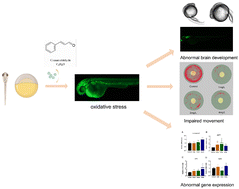Toxicology studies provide a reliable dose range for the use of compounds. Zebrafish show unique advantages in toxicology research. Cinnamaldehyde (Cin) is one of the main active compounds isolated from Cinnamon trees and other species of the genus Cinnamomum. In this study, we investigated the developmental neurotoxicity of cinnamaldehyde in zebrafish and preliminarily explored its underlying mechanism. Cinnamaldehyde causes developmental neurotoxicity in zebrafish, as evidenced by the damage to ventricular structures, eye malformations, shortened body length, trunk curvature, decreased neuronal fluorescence, and pericardial oedema. Moreover, it can induce abnormal behaviour and gene expression in zebrafish. After treatment with the oxidative stress inhibitor astaxanthin, the behaviour and abnormal gene expression were reversed. All of these data demonstrated that the developmental neurotoxicity of cinnamaldehyde might be attributed to oxidative stress. In addition, this study also confirmed that zebrafish is a reliable model for toxicity studies.

